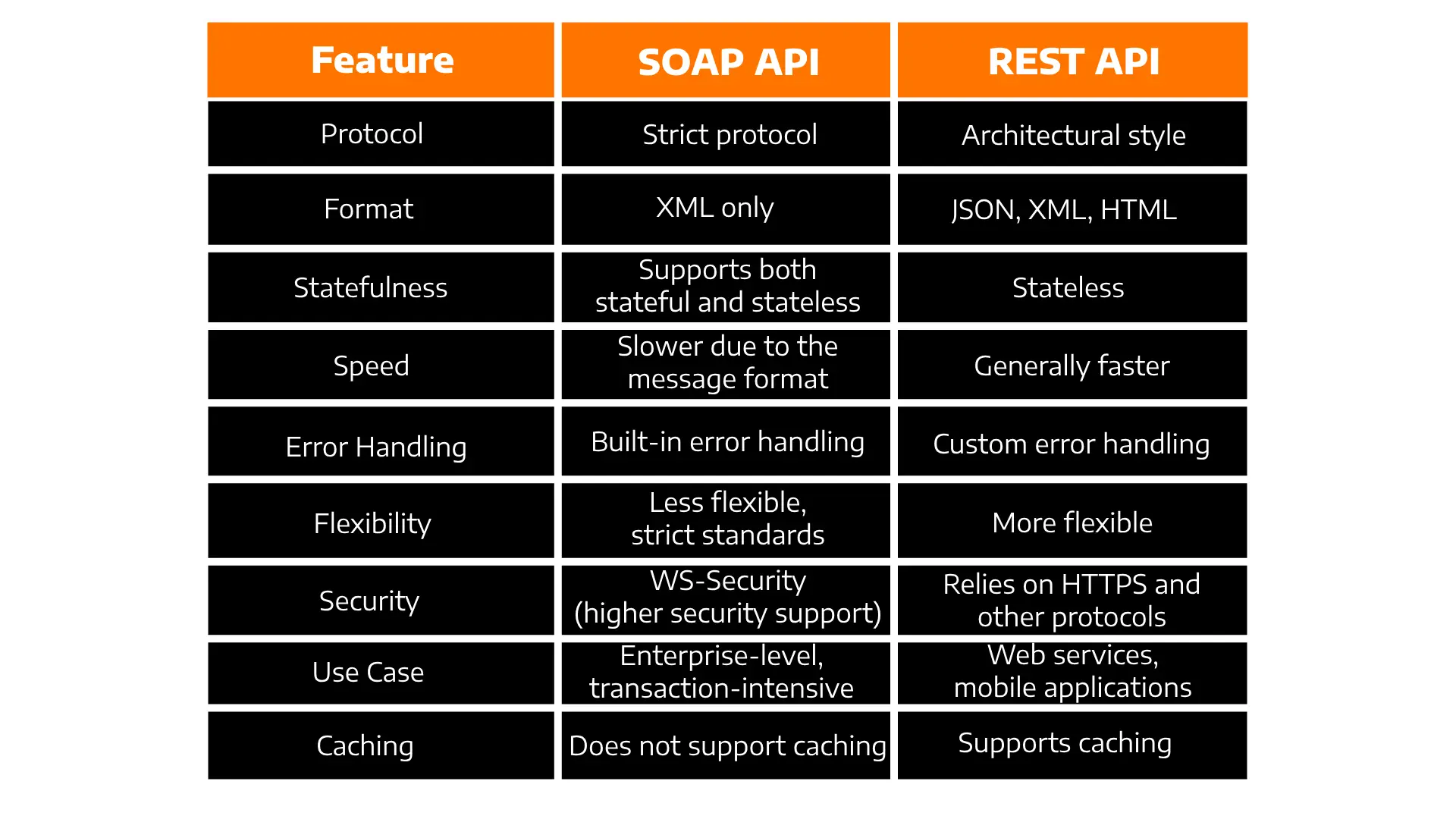SOAP API serves as the focal point of this guide, where you’ll embark on a comprehensive exploration of its intricacies. We will cover its structure and benefits, delve into real-world use cases, and discuss its limitations. By the end of this guide, you will gain a thorough understanding of why SOAP remains relevant in today’s tech landscape, when it is the optimal choice for your needs, and how to effectively integrate it into your next project.
Table of Contents
Introduction of Soap API
SOAP API is a crucial component in the world of application programming interfaces (APIs), particularly in industries that require strict security, detailed error handling, and platform independence. While you might be familiar with other prominent API styles like REST and GraphQL, SOAP stands out as a protocol-oriented messaging system that offers a highly structured approach to connecting and exchanging data between different applications across various platforms and languages.
Why is this important? In sectors such as finance, telecommunications, and government, secure and reliable data exchange is not just a luxury; it’s a necessity. SOAP is specifically designed to meet these demanding requirements, ensuring that data is transferred securely and accurately.
What is SOAP API?
SOAP API is a protocol designed to facilitate communication between different systems over the internet. Unlike simpler, more flexible alternatives like REST, SOAP enforces strict standards and uses XML exclusively for its messaging format. Developed initially by Microsoft in the late 1990s, SOAP has since been adopted as a web standard by the World Wide Web Consortium (W3C).
The Role of XML in SOAP
SOAP is entirely built around XML (Extensible Markup Language), a language that allows data to be formatted in a structured and human-readable way. This XML structure enables SOAP messages to be platform-independent—meaning that you could send a SOAP message from a Linux server, receive it on a Windows client, and vice versa, with no issues. XML also helps ensure data integrity since every message is strictly formatted, allowing both sender and receiver to validate the content before acting on it.
Why Use SOAP API Over Other APIs?
SOAP is often chosen for scenarios where security and reliability are paramount. For example, if you’re managing a banking transaction system, data integrity and security take precedence over speed and flexibility. SOAP has built-in error handling and supports various security protocols like WS-Security, making it ideal for applications that require robust security features and detailed error reporting.
How SOAP API Works?
Every SOAP message has a specific format, making it easy to recognize and interpret. Each message consists of four main parts: Envelope, Header, Body, and Fault. Let’s explore each of these components.
Envelope
The Envelope is the root element of every SOAP message. It signals that the enclosed content is a SOAP message, setting the structure for the entire message. Think of the envelope as the outer packaging of a letter; it contains and protects everything inside. The envelope also defines two important child elements: Header and Body.
Example:
xml
Copy code
<soap:Envelope xmlns:soap=”http://www.w3.org/2003/05/soap-envelope”>
<soap:Header> … </soap:Header>
<soap:Body> … </soap:Body>
</soap:Envelope>
Header
The Header element is optional but often used for metadata or additional information about the message. This could include security tokens, transaction IDs, or other data that helps to contextualize the message. For example, if you need to authenticate a user or specify how the message should be processed, you’ll include these details in the header.
Example:
xml
Copy code
<soap:Header>
<auth:Credentials xmlns:auth=”http://example.com/auth”>
<auth:Username>JohnDoe</auth:Username>
<auth:Password>SecurePass123</auth:Password>
</auth:Credentials>
</soap:Header>
Body
The Body is the main content area of a SOAP message. It holds the actual data intended for the recipient. The Body is where you specify what action you want the recipient to perform, such as querying a database, updating a record, or performing a calculation.
Example:
xml
Copy code
<soap:Body>
<m:GetAccountInfo xmlns:m=”http://example.com/account”>
<m:AccountNumber>123456789</m:AccountNumber>
</m:GetAccountInfo>
</soap:Body>
Fault
The Fault element handles error reporting in SOAP. If an issue arises during the processing of a SOAP message, the Fault element is used to specify the error details. This element is particularly useful for debugging and error handling because it allows you to understand exactly what went wrong.
Example:
xml
Copy code
<soap:Fault>
<faultcode>soap:Client</faultcode>
<faultstring>Invalid account number</faultstring>
<faultactor>http://example.com/account</faultactor>
<detail>Account number does not exist in the system.</detail>
</soap:Fault>
Benefits of SOAP APIs
Security
SOAP is compatible with WS-Security, a protocol that allows for encryption, authentication, and integrity checks. This makes it a go-to choice for industries dealing with sensitive information, such as healthcare, finance, and government. SOAP can also work over HTTPS, adding an additional layer of security.
Reliability
Thanks to its standardized format, SOAP messages are highly reliable. Each message is processed according to a strict structure, minimizing the chances of data corruption or misinterpretation. The built-in error handling also contributes to SOAP’s reliability by allowing issues to be identified and resolved quickly.
Platform Independence
SOAP is designed to be platform-independent, which is essential for systems that need to communicate across various operating environments. As long as both sender and receiver understand XML, SOAP can work seamlessly, regardless of the underlying platforms.
Flexibility with Transport Protocols
Not only does SOAP work with HTTP, but it also supports other protocols like SMTP, TCP, and FTP. Because of its adaptability, SOAP can function in settings where REST and other APIs would not be practical.
When SOAP Isn’t the Best Fit?
SOAP isn’t always the ideal solution, particularly for lightweight, stateless applications where flexibility and speed are more important than strict security and error handling.
Lack of Caching Support
Unlike REST, which can leverage caching to improve speed, SOAP doesn’t support caching. This can slow down applications where data doesn’t need to be updated frequently.
Complexity and Overhead
SOAP’s strict structure can lead to larger message sizes, which increases network traffic and can slow down performance. The XML format is also more complex and requires more processing power to parse, making it less ideal for mobile apps or simple web services.
Limited Flexibility
SOAP’s exclusive use of XML makes it less versatile than REST, which supports multiple data formats, including JSON and plain text. For modern web and mobile applications that prioritize speed and flexibility, SOAP may not be the best choice.
Common Use Cases for SOAP APIs
Bank Transfers
Banks require high levels of security and error handling to prevent fraudulent transactions and ensure accuracy. SOAP’s support for WS-Security and reliable error reporting makes it a perfect fit.
Flight Bookings
Airlines frequently use SOAP to handle booking requests, as the strict protocol ensures availability checks and confirmations are accurate and secure.
Telecommunications Billing Services
Airlines frequently use SOAP to handle booking requests, as the strict protocol ensures availability checks and confirmations are accurate and secure.
City Management Systems
City services, like traffic control and utility monitoring, need reliable communication protocols to function smoothly. SOAP enables these systems to interact effectively and ensures that all data exchanges are accurate and reliable.
Shipping and Logistics
Shipping companies often use SOAP to manage complex logistics and tracking operations. SOAP ensures that every message is secure and that data remains consistent, even across different locations and systems.
Difference Between SOAP API and REST API
Typically sent via HTTP or SMTP, a protocol-based online service known as a (Simple Object Access Protocol) SOAP API uses XML to format messages and adheres to stringent standards. It supports stateful operations and has built-in error management. When compared to SOAP, a (Representational State Transfer) REST API is typically more lightweight, quick, and versatile because it leverages HTTP methods (such as GET, POST, PUT, and DELETE) for communication. Because of their statelessness and compatibility with numerous formats, REST APIs are ideal for web applications that need to scale.
To make things easier to understand, the SOAP technique is quite organized and makes use of the XML data format. Adaptability is increased as a result of REST, which enables applications to share data in a variety of forms.

Conclusion
While SOAP might seem outdated compared to more flexible protocols like REST, it remains a valuable tool in many industries. Its emphasis on security, structure, and reliability makes it particularly suitable for sectors that cannot compromise on data integrity. If you’re dealing with applications where security and error handling are paramount, then SOAP could be the right choice.
In today’s API landscape, SOAP coexists with newer protocols, providing a structured, reliable, and secure means of data exchange. Whether you’re developing a banking application, a healthcare system, or any other service where data accuracy and security are essential, SOAP remains a strong and dependable option. So, when choosing the right API for your project, consider SOAP—especially if your needs align with its strengths.
Frequently Asked Question
What makes the SOAP API suitable for international applications?
The XML-based SOAP API doesn’t care about your language. This feature makes it simple to communicate with systems located in different locations and using different computer languages. It works with a lot of different platforms, which makes it a fantastic choice for foreign applications.
How do I maintain SOAP API versions without confusing users?
Make changes clear, and for versioning, use separate namespaces. If you maintain backward compatibility and provide clear directions, customers won’t encounter any issues when switching between versions.
Is it possible to use SOAP APIs for microservice architecture?
In fact, the SOAP API and microservices systems can work together effectively. The SOAP API with microservices may be heavier than REST. Careful design is necessary for SOAP services to function properly in a microservices environment.
What are the common misconceptions about the SOAP API?
Some think SOAP is less open and current than REST, but this is not true. For apps that need strict reliability and security, SOAP is still useful, even though it may be more strict. Its organized way of doing things makes it useful for combining complicated business processes.
Can I convert a SOAP API to REST easily?
Making a few style changes to a SOAP API transforms it into a RESTful interface. Change the payloads from XML to JSON, and write the API paths according to REST standards. Implementing this change could enhance the functionality and user-friendliness of certain apps. However, the development process may take longer.










